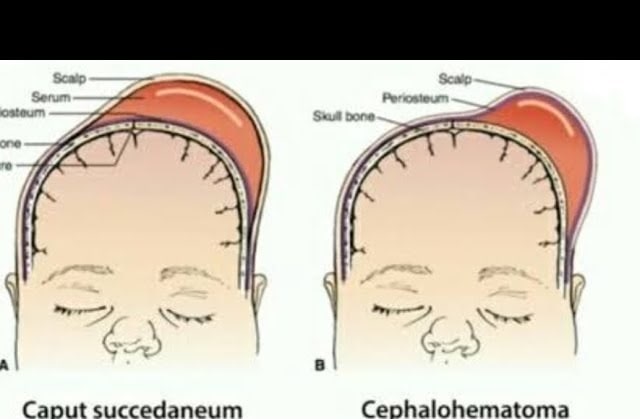Caput Succedaneum
Caput succedaneum is a swelling (edema) that affects the scalp of a newborn baby.
This condition most often occurs due to pressure on the baby’s head as it moves through the birth canal during a long or difficult vaginal delivery.
In this condition, fluid builds up under the scalp, causing swelling. The baby’s head may be cone-shaped at birth.
Symptom Of Caput Succedaneum
The main symptom of this condition is swelling under the scalp. The skin is swollen and tender. If pressed, it can cause a dimple in the flesh.
The swelling may be on one side or extend to the midline of the scalp. It is usually most noticeable on the part of the skull that first descends into the birth canal.
In addition, there may be discoloration or bruising, although not extensive.
Once the swelling goes down, you may notice that your baby’s head is slightly pointed due to pressure on the skull bones.
This will disappear over time. The baby’s skull bones are not fused together and can move without damage.
However, a physical examination of the newborn is essential for diagnosis.
Causes of Succeeding Head
This condition occurs due to the accumulation of body fluid between the baby’s scalp and the protective membrane that covers the skull bones. This membrane is called the periosteum.
Here are some causes of caput succedaneum that you need to know:
1. Childbirth
A baby’s body is very fragile and therefore very susceptible to bruising. This condition occurs when the baby’s head is squeezed or pulled. This most often occurs during labor.
The process of labor puts a lot of pressure on the baby. Even though the cervix and vaginal canal are dilated during labor, they still press on the baby. This can cause swelling after the baby is born.
Labor that takes a long time or requires the use of forceps (a vacuum suction device) can increase the risk of swelling.
2. Insufficient amniotic fluid
The baby’s scalp may swell if the amniotic sac ruptures early during labor.
Likewise, if the baby is in the amniotic sac with too little fluid, he can experience bruising on his mother’s pelvic bone while still in the womb.
This can cause caput succedaneum before the baby is born.
Risk Factors Head Succedaneum
Several factors can also increase the risk of this condition, namely:
- Having a long or difficult labor.
- Premature rupture of membranes.
- Low levels of amniotic fluid in the uterus.
- Giving birth to a baby for the first time.
- Braxton-Hicks contractions.
- Certain fetal positions, such as head down.
- Delivery requiring instruments, such as forceps.
Diagnosis of Headache
This condition is often identified on physical examination without the need for additional testing.
If there are more worrisome issues, your doctor may recommend further tests to evaluate for more serious problems.
In some cases, a skull fracture may occur. The doctor may perform an X-ray to evaluate the skull bones.
Treatment of Succedaneum Head
There is no treatment for caput succedaneum, as it is not life-threatening. It usually resolves on its own.
However, this condition may cause some discomfort to the baby.
However, it does not cause severe pain, nor does it require special treatment.
Complicated Head Succedaneum
Potential complications of caput succedaneum include:
1. Hair loss
Some babies experience hair loss (alopecia) in the form of rings or halos at the site of the swelling. It’s a good idea to know what alopecia is .
Prolonged pressure on the baby’s scalp during delivery can damage the tissue, causing temporary hair loss.
In rare cases, scars form on the scalp and cause permanent hair loss.
2. Jaundice
Swelling and bruising can increase the level of bilirubin in the blood, which causes jaundice.
Your baby’s eyes or skin may appear yellow. This condition usually resolves on its own.
Preventive replacement head
Most causes of caput succedaneum are beyond anyone’s control.
For example, sometimes doctors rush the delivery process or make mistakes when removing delivery tools, such as forceps.
If the error results in the child being born with severe caput succedaneum, it could be that the doctor has committed medical negligence.
When to See a Doctor?
The health of the baby is the most important thing. Whenever parents have questions about health or whether something is wrong, it is better to be safe than sorry.

